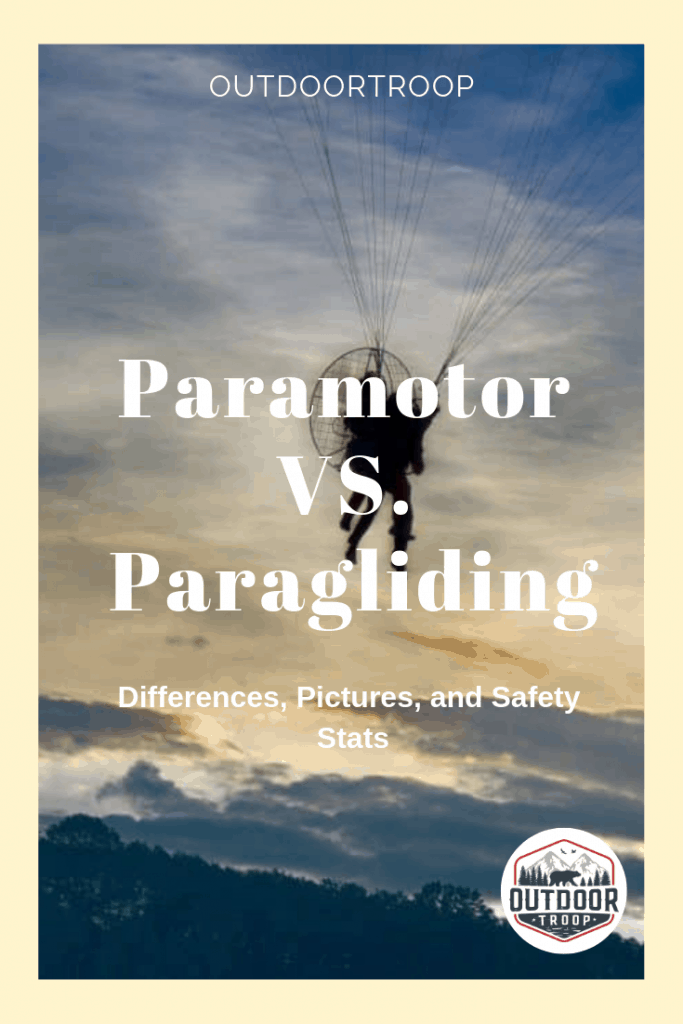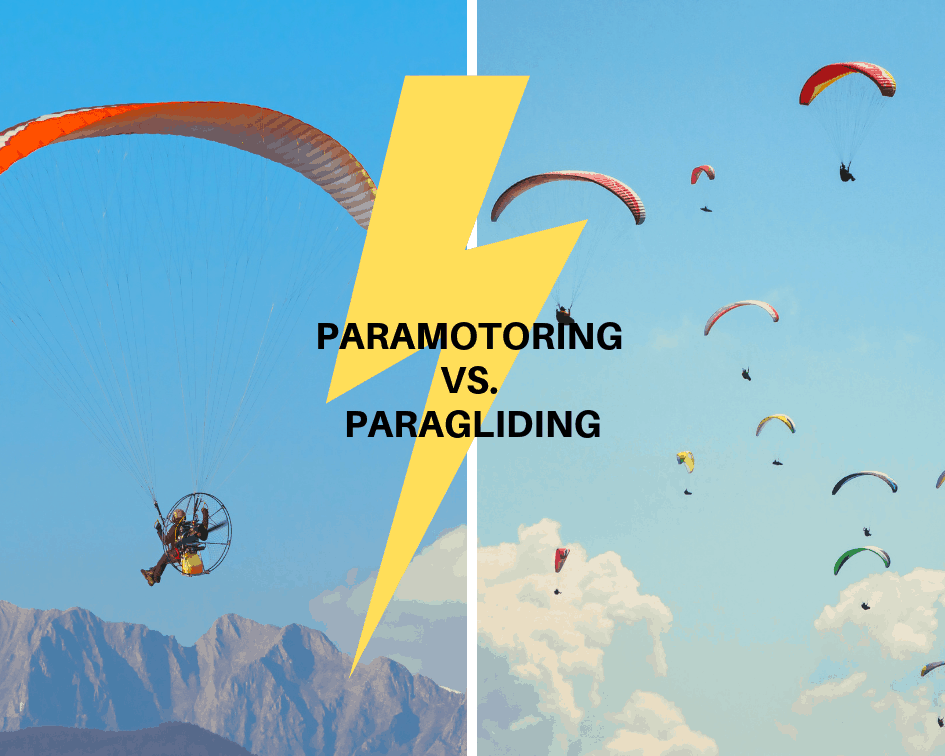
If you’re interested in paramotors and paragliders, you may be wondering what makes them different! They are fairly similar in design and function but there is a key difference.
What’s the difference between a Paramotor and a Paraglider? The main difference between paragliding and paramotoring is that a paraglider only uses a wing and environmental factors to gain altitude and speed, while paramotors use a giant fan to move the pilot forward and upward.
Paramotoring and paragliding have many other similarities and differences. What are some of these differences, and how do they stack up to each other?
| Paramotoring | Paragliding | |
| Fatalities Per Year | 1/1504 | 1/752 |
| Changes a Motor Makes | Additional Maneuverability | Lighter |
| Where can they be Launched? | Any open field, hill top, or mountain | Hill top, or mountain |
| Difficulties with Learning | Maintenance | Finding Thermals |
| Differences in Wings | Trimmers | No Trimmers |
| Relation to the Wind | Unreliant upon Wind | Reliant upon Wind |
| Cost | $5,500 | $2,500 |
| Maintenance | Motor + Wing | Wing |
Differences in Safety Statistics
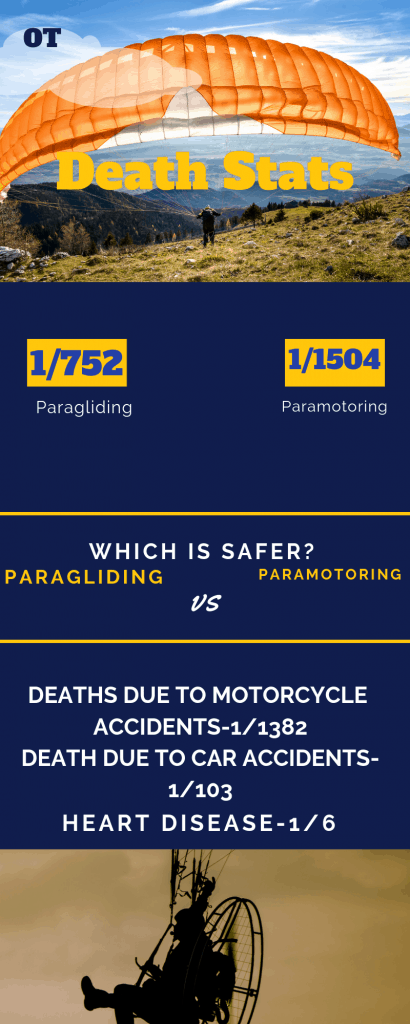
When weighing the pros and cons of Paramotoring and Paragliding against each other, one of the most important things to look at are the fatality rates of each of the sports.
The probability of being in an accident with a paramotor is about 1/1504 (per year).
Paragliding, on the other hand, has a statistical probability of 1/752 fatalities per year. This is double the amount of deaths that have been seen in paramotoring.
These are dangerous sports, but all things considered, the statistics aren’t terrible. Motorcycling has a statistical death rate of 1/1382 every year. Car crashes have a fatality rate of 1/103 crashes. Falls have a probability of 1/114 falls being fatal.
If you want to avoid death, it’s best to avoid taking up such an exciting sport, as one of every six people you know will die of heart disease.
Paragliding is about twice as likely to kill you than paramotoring, but there are many more activities that are more dangerous.
For more information on death statistics relating to paramotoring and paragliding, and for some useful tips on how to make sure you aren’t among the unlucky, check out this article.
Changes That a Motor Makes
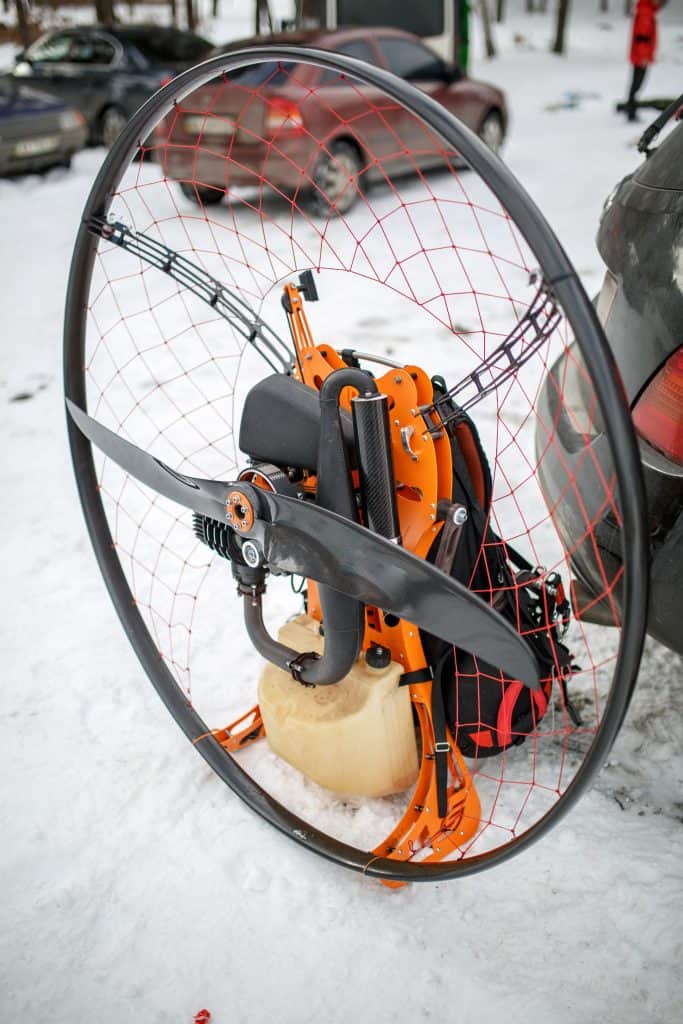
One of the most obvious differences between paramotoring and paragliding is the motor. Just what does this motor do though?
The motor turns a paraglider into a more maneuverable machine. Being able to gain elevation quickly, without needing to rely on thermals can be a huge asset. Having a motor also makes launching easier, and by extension makes launch sites much easier to find.
Fun Fact: Paramotors weigh on average about 50 lbs.
Paragliders have a few advantages over paramotors though. Motors are very heavy for one thing, making transport difficult. Buying and maintaining a motor is also wildly more expensive than only needing to maintain a wing.
Paramotors are flexible with how they can move, and where they can be launched from, but they are expensive and require a high amount of upkeep.
Where and When Can They be Launched?
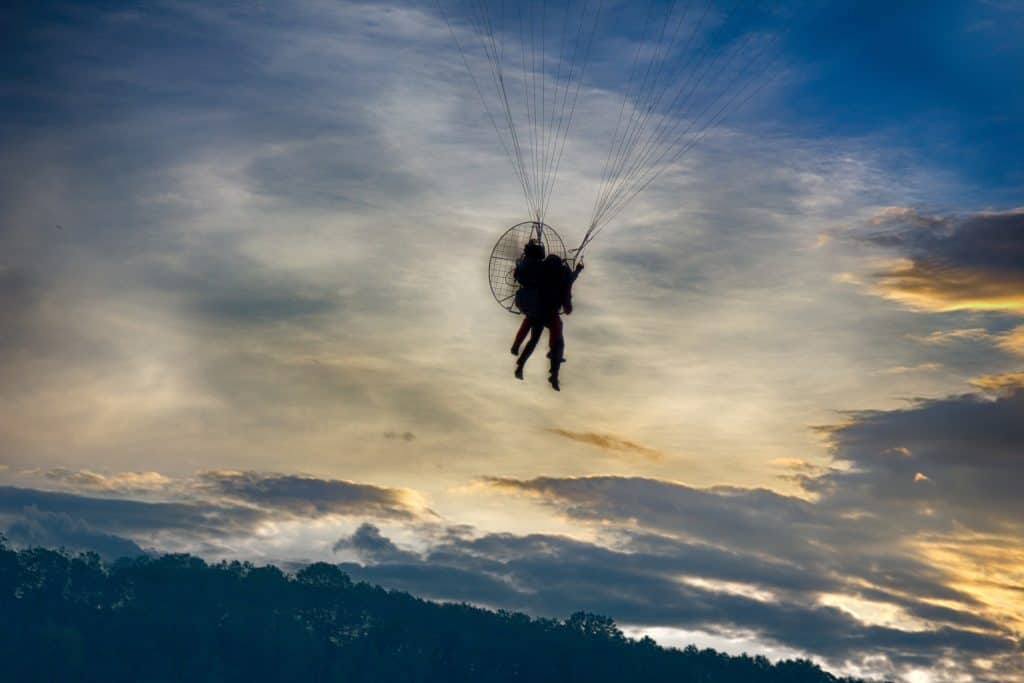
Other things to consider when comparing paramotoring and paragliding are the places and times that they can be launched.
Paramotoring is much more versatile than paragliding in how they can be launched. You can take off from practically any open field. When paramotoring, you just have to be careful to not hit any power lines, trees, or other obstacles while taking off.
Paramotors are only restricted by the fact that they can’t really be launched while running up a hill.
In contrast to the paramotor, paragliders can only be launched from a hilltop. Finding an adequate hill can be a challenge, and you may need to drive a good distance to a site where conditions are optimal.
Fun Fact: Flying Paramotors and Paragliders at night is illegal! Be careful about the choices you make.
As far as wind conditions go, this is an air sport. So wind conditions have to be within a set standard. Typically paramotors have a greater amount of flexibility than paragliders when faced with different wind conditions. They work best in wind speeds from 0 mph to 12 mph, but wind speeds that are higher are still very much manageable.
Wind gusts affect paramotors as well. Typically, If the wind gusts are 5 mph above whatever the average is that day, it’s best to not go out. But they can handle wind gusts less than that handily.
Paragliding, on the other hand, relies solely on the wind. There is no motor to propel the paraglider forward, and if the wind conditions aren’t perfect, it won’t be a very long flight.
The ideal conditions for paragliding are when wind speeds are between 2 and 18 mph. For beginners, wind speeds should be 2 mph to 12 mph. Paragliders do not work well in zero-wind conditions.
Paragliders gain altitude through a phenomenon called thermals, where the sun heats a pocket of air, which rises up into the sky past the colder air around it. If you catch a thermal, you can rise high up into the air.
Though paramotorists use thermals in addition to their motor, paragliders rely on thermals completely for any elevation after a launch. Because of this, conditions must be right in order for thermals to form.
It doesn’t have to be a completely clear and sunny day to go paragliding, but any rain or chance of rain should be a clear sign to call it a day and pack up, for both paramotorists and paragligers.
Popularity Around the World
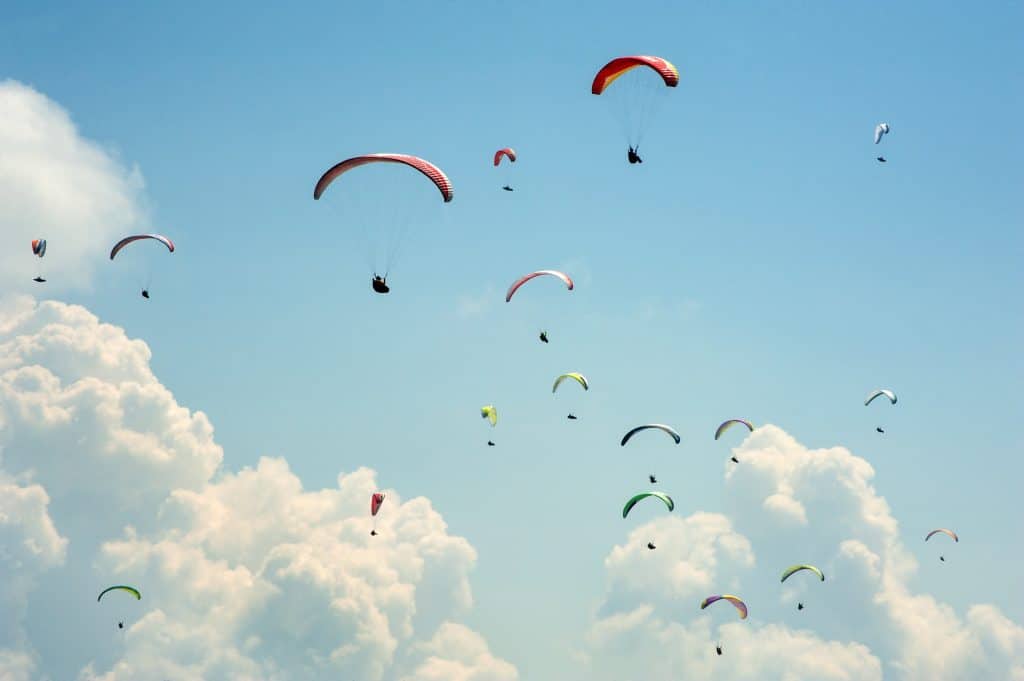
As far as popularity goes, paragliding is the more well known and popular as an activity. Because it is so much cheaper than paramotoring, tandem paragliding flights make for great tourist attractions.
This being said, paragliding is also a sport that is rather localized to mountain range areas. Because the best launch points tend to be high up in the air, mountain ranges are where paragliding companies tend to focus their advertising.
Paramotoring, on the other hand, has a rather small cult following. The fans are scattered all over the world, although many
Paramotorists also tend to like mountainous areas for many of the same reasons that paragliders do. Thermals are easier to find, there are interesting wind patterns in mountain ranges, and the views are just breath-taking.
Fun Fact: Paragliding was started up in June 1978 by three friends, Jean-Claude Bétemps, André Bohn and Gérard Bosson, from Mieussy, Haute-Savoie, France.
There are a number of festivals that take place around the world that celebrate both paramotoring and paragliding. One such festival is the Paragliding Festival which takes place in India. Tourists who are craving for some adventure can be a part of the Paragliding Festival at the Satpura range.
The 26-day long Paragliding Festival receives more than 5000 entries from far-flung places every year. Training sessions are also conducted for the novices by the expert pilots. Both adults and kids can take part in paragliding. The sole reason for celebrating the festival is to promote Satpura as a paragliding destination.
Another exciting festival to attend is the Andes Open, which takes place in Merida, Venezuela. This 6-day festival takes place from January 2nd through January 8th and is a place where paramotor enthusiasts can gather together to enjoy the sport together.
There are also competitions for
In this intense race,
You can see one of the previous Icarus Race’s winners here.
Paramotoring VS Paragliding: Which is Easier to Learn?
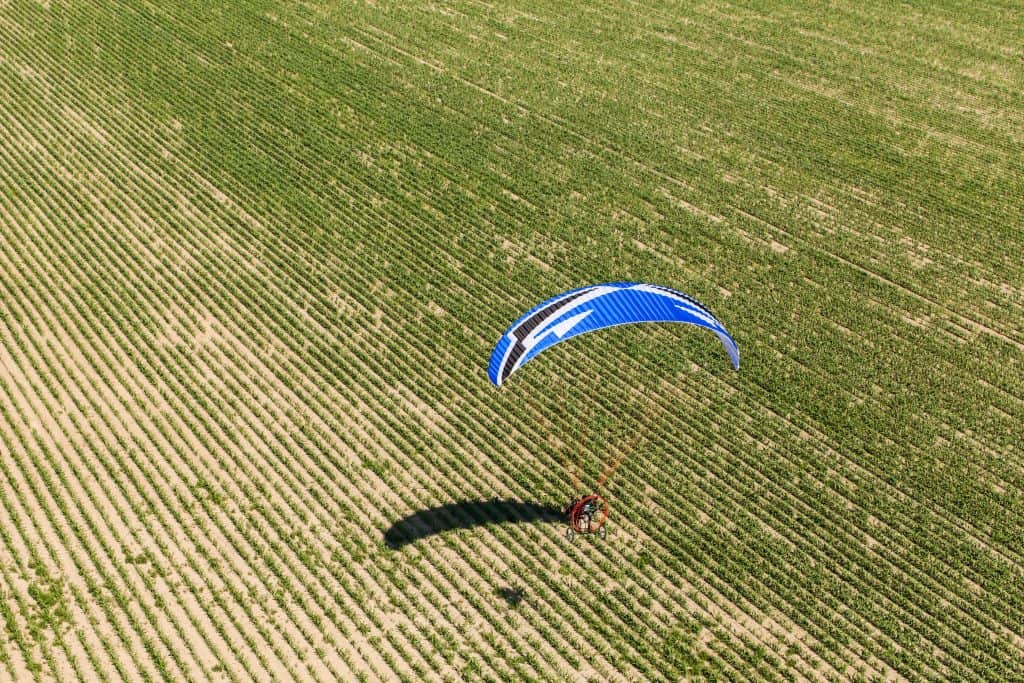
Paramotoring is by far the easier of the two to learn. Paramotoring, with the addition of an engine propelling you forwards, is easier to get a grip on. Finding and using thermals to their fullest potential is a skill that must be picked up for both sports, but especially for paragliding.
In paramotoring, you have more control over where you can be, and what you need to be doing at any specific time, while paragliding is much more of a mental process. Paramotoring can be thought of as doing the math on paper, while paragliding is doing mental math.
You have clear and tangible cause and effect relations between making the engine go more, and going up when it comes to paramotoring. In paragliding, the reason you are rising comes from an in-depth understanding of wing patterns, and how to use them to your advantage.
In order to be proficient in either paramotoring or paragliding, you must understand the wind, but a total novice would be able to pick up paramotoring much more quickly than paragliding.
Fun Fact: The greatest cause for accidents with paramotors is pilot error.
Of course, you shouldn’t just try to learn to paramotor or paraglide on your own. There are special training schools for both paramotoring and paragliding. These are institutions where you will learn the basics of both paramotoring and paragliding.
Spending about a week in a facility, you will do book study while inside, and while outside, you’ll practice handling and maneuvering a wing.
When looking at the differences between the schools, paramotoring school should teach you a lot about both paramotoring and paragliding, but it certainly still has that aspect of motorized flight ingrained in the curriculum.
Paragliding schools, on the other hand, are far more weighted on book study. By the end of either session, you should be well versed in the parts of the wing, what they do, how changing wind patterns will affect you, and how to react in emergency situations.
Looking up local schools near you is not difficult, but most schools will close for the winter, so keep that in mind when trying to find a school to attend.
Differences in Wings
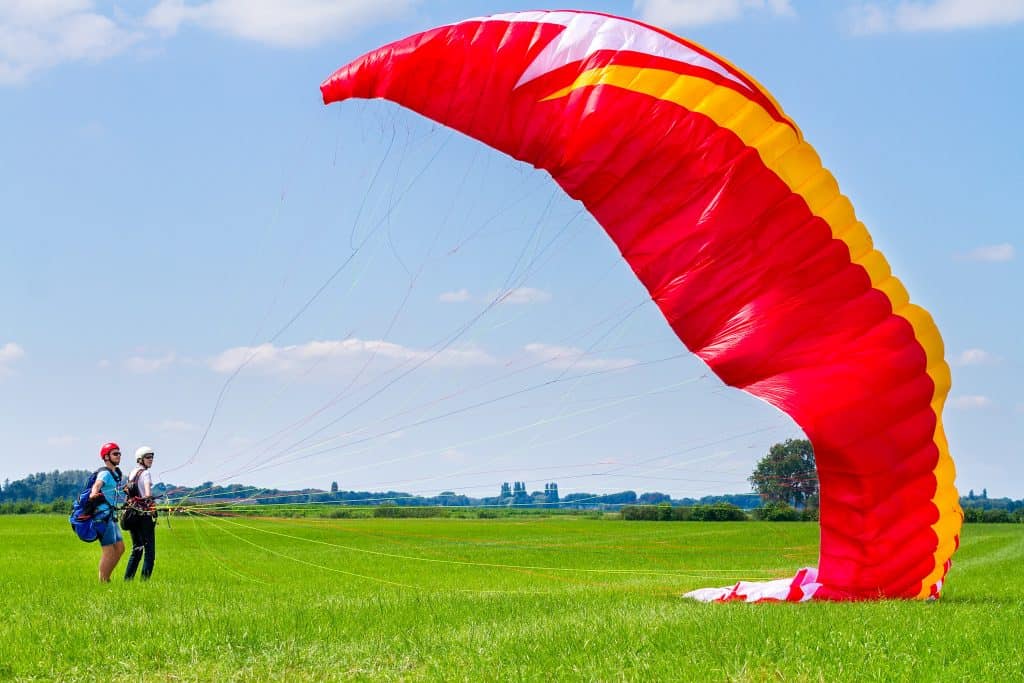
The wings used for paramotoring and paragliding are very similar but have a few small differences that can make a big difference.
Trimmers are an extra line that can pull the wing tips in slightly, and when active act similar to a speed bar in that they make the paramotor/paraglider go faster.
Paragliding wings do not typically have trimmers. They’re expected to be flown in more active air, and having trimmers increases the possibility of violent whipping maneuvers in the air.
Reflex paragliding wings have trimmers but are for more experienced paragliders who, (need I say it), have the reflexes necessary for maneuvering a paraglider with trimmers.
Fun Fact: The speed range of paragliders is typically 20–75 kilometers per hour (12–47 mph).
In paramotors, trimmers are less of a risk. The engine takes away most of the issues with The trimmers also increase the weight allowance of the wing.
Most paragliding wings can be used as paramotor wings, but some will not have the weight allowance required. Always check to be sure that your wing can hold the weight you’re going to put on it.
There are other subtle differences that make it easier to fly for the specific type of flight that the wing was made for. The positioning of the wing when taking off, as well as in the air is slightly shifted, due to weight distribution and the requirements needed to get an entire person off the ground vs the requirements needed to get an entire person plus an engine off the ground.
If you’re looking for Paragliding wings, a good place to look is peaktopeakparagliding.com, which has a wide selection of paraglider wings for you.
For wings more suited to paramotoring, try flybubble.com for some good deals on wings.
Utilizing the Wind: Paramotors VS Paragliding

In air sports like paragliding and paramotoring, the wind is a very important factor to consider. The way that each of these sports interacts with the wind can differ significantly.
In paragliding, it’s impossible to get a good flight with no wind. When there is wind, conditions must be near perfect for the flight to go well. Launching from a high point helps to stay aloft for a long time, but in the end, paragliding is very reliant upon the wind to be gracious.
Paragliders make use of thermals. Thermals are pockets of air that the sun heats up, and they can be many kilometers long. As we all know, warm air rises. Paragliders must be able to take advantage of thermals that they find and use them to be lifted into the sky.
Fun Fact: A variometer is used to help pilots find and stay in the “core” of a thermal.
Paragliders need to fine tune their thinking to be able to find these thermals. There are places where thermals can be found commonly, and launch sites can be set up near these locations, but when flying on their own, paragliders need to be able to find these thermals on their own as well.
Paramotors, however, are far less reliant on thermals, or even wind for that matter. A paramotor can take off in zero-wind conditions, and not find a single thermal, and still get to ridiculous heights.
The paramotor’s advantage over the paraglider comes from its motor. Paramotors don’t need the wind if they can generate their own momentum. Paramotors have the unique advantage of being able to utilize the wind much the same way paragliders do, while also being able to manipulate themselves.
A paramotorist who finds himself too low can instantly begin to climb in elevation, while a paraglider in the same position would be forced into either landing or trying to get lucky with the wind.
Paramotoring’s true advantage over paragliding is that it is far more maneuverable and flexible in what it can do situationally than a paraglider.
The Cost of Paramotoring Against the Cost of Paragliding
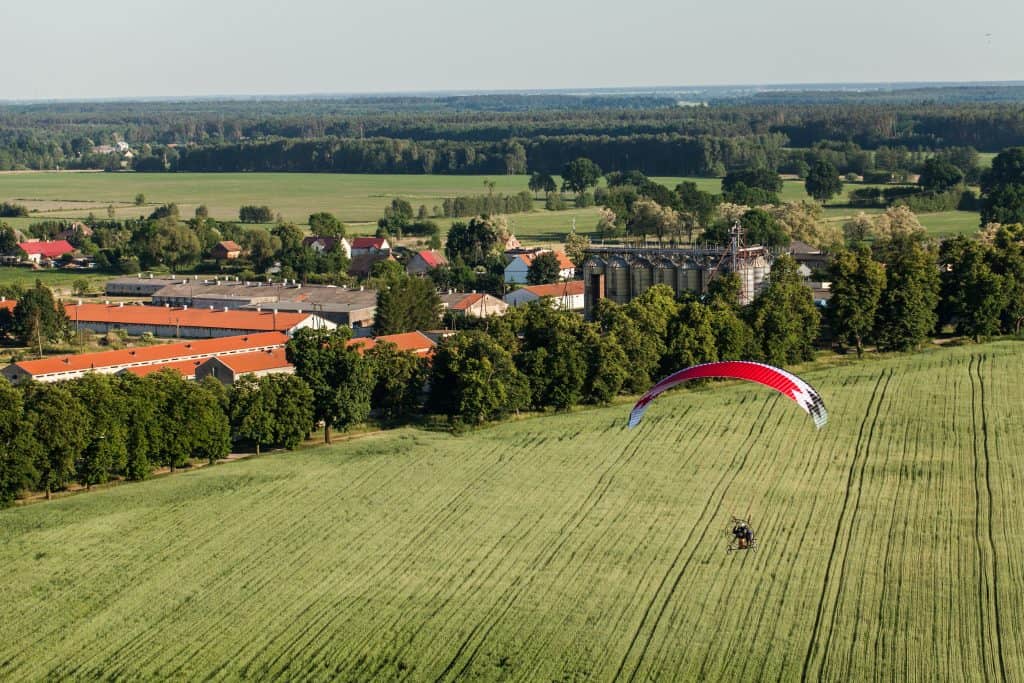
One of the main concerns with paramotoring is its high cost. Paragliding is expensive enough if you want a good wing, and paramotoring is much more costly. Basic motors cost upwards of $3000, plus a typical wing (~$2500), and you get a cost of around $5500 just for the wing and motor.
Motor upkeep is expensive and time-consuming as well. If you fly your paramotor often, you should be doing maintenance for every 10 hours of flight.
The cost of gas will stack up over time as well if you fly a paramotor. Depending on the engine you have, you can end up using fuel at a rate of 1.5 to 4 liters of fuel per hour.
Fun Fact: There are such things as 4-stroke paramotors, and they’re gas guzzlers.
When it comes to paragliding, the only thing you need to purchase is the wing. Purchasing a wing is still a high cost compared to most other purchases (sitting at around $2500 dollars with the paramotoring wings) but with paragliding wings, that’s the only purchase you’ll need to make.
Maintaining the paragliding wing is much easier and cheaper than maintaining the wing in addition to a 2-stroke engine.
However, one should factor in how far launch sites are from their house. Sometimes, if the locations are far enough away, you may as well have a paramotor for how much gas you use getting to the launch site.
Maintenance of Paragliders and Paramotors

Fun Fact: About 2.6% of all paramotor accidents have to do with water immersion.
Just like any sport, the equipment used must be checked and kept up to date. The maintenance for paragliding is a bit easier than the maintenance for paramotoring.
For paragliding, maintenance mainly consists of the following:
- Check to make sure there are no holes or tears
- Clean wing after landing and before packing the wing up
- Choosing to launch from areas that are safe for the wing, without gravel, brush, etc.
- Be sure the wing is dry before packing it
- Test the integrity of the line connections
When maintaining a paramotor, you should follow all the above steps for the wing you are using, in addition to steps to caring for the motor.
Motor
- Check the spark plug
- Tighten the bolts (torque the head)
- Readjust and tighten the prop rig
- Check for any gas leaks
- Ensure integrity of the rubber mounts
- Verify idle stability
It’s best to do maintenance for every 10 hours of flight.
No matter what, whether you have a paraglider or paramotor, you should follow the detailed instructions that the manufacturer provides for the users on how to maintain their product.
Do Laws Apply Differently to Paragliding and Paramotoring?

Because both paramotors and paragliders are foot launched, they do not require a license to fly. However, both are still bound by aviation law. Aviation law is the branch of government that deals with anything that flies.
Fun Fact: If you need to run from the cops and you’re using a paraglider to escape, you’re better off turning yourself in.
Because of this, there are some restrictions on what can and cannot be done while in flight, when one can fly, and where one can fly.
For example, when paragliding or paramotoring, you are not permitted into restricted airspace. You may not drop things from your aircraft, or fly in conditions that are too turbulent. Look up your local laws concerning ultralights before flying.
Related Questions
What should I wear when paramotoring/paragliding? When paramotoring or paragliding, it can get very cold. Always be sure to wear warm clothing and winter gloves when flying paramotors or paragliding. For a complete list of equipment that you might want for your flights, click here.
What are some good Paramotoring/Paragliding Schools to go to?There are many different paramotoring and paragliding schools out there. Our advice would be to ask yourself these questions when you’re considering a school:
- Are these experiences instructors that teach at the school?
- Does this school have a good history?
- Does the school operate when I’ll have free time?
- Does the school offer many brands of paramotor or paragliding wings/motors?
Asking these questions while searching for a school will help you find a good school close to your location.

